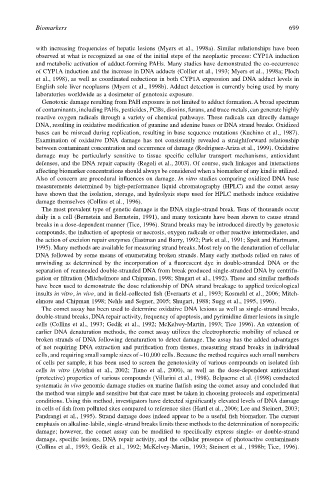Page 719 - The Toxicology of Fishes
P. 719
Biomarkers 699
with increasing frequencies of hepatic lesions (Myers et al., 1998a). Similar relationships have been
observed at what is recognized as one of the initial steps of the neoplastic process: CYP1A induction
and metabolic activation of adduct-forming PAHs. Many studies have demonstrated the co-occurrence
of CYP1A induction and the increase in DNA adducts (Collier et al., 1993; Myers et al., 1998a; Ploch
et al., 1998), as well as coordinated reductions in both CYP1A expression and DNA adduct levels in
English sole liver neoplasms (Myers et al., 1998b). Adduct detection is currently being used by many
laboratories worldwide as a dosimeter of genotoxic exposure.
Genotoxic damage resulting from PAH exposure is not limited to adduct formation. A broad spectrum
of contaminants, including PAHs, pesticides, PCBs, dioxins, furans, and trace metals, can generate highly
reactive oxygen radicals through a variety of chemical pathways. These radicals can directly damage
DNA, resulting in oxidative modification of guanine and adenine bases or DNA strand breaks. Oxidized
bases can be misread during replication, resulting in base sequence mutations (Kuchino et al., 1987).
Examination of oxidative DNA damage has not consistently revealed a straightforward relationship
between contaminant concentration and occurrence of damage (Rodriguez-Ariza et al., 1999). Oxidative
damage may be particularly sensitive to tissue specific cellular transport mechanisms, antioxidant
defenses, and the DNA repair capacity (Regoli et al., 2003). Of course, such linkages and interactions
affecting biomarker concentrations should always be considered when a biomarker of any kind is utilized.
Also of concern are procedural influences on damage. In vitro studies comparing oxidized DNA base
measurements determined by high-performance liquid chromatography (HPLC) and the comet assay
have shown that the isolation, storage, and hydrolysis steps used for HPLC methods induce oxidative
damage themselves (Collins et al., 1996).
The most prevalent type of genetic damage is the DNA single-strand break. Tens of thousands occur
daily in a cell (Bernstein and Bernstein, 1991), and many toxicants have been shown to cause strand
breaks in a dose-dependent manner (Tice, 1996). Strand breaks may be introduced directly by genotoxic
compounds, the induction of apoptosis or necrosis, oxygen radicals or other reactive intermediates, and
the action of excision repair enzymes (Eastman and Barry, 1992; Park et al., 1991; Speit and Hartmann,
1995). Many methods are available for measuring strand breaks. Most rely on the denaturation of cellular
DNA followed by some means of enumerating broken strands. Many early methods relied on rates of
unwinding as determined by the incorporation of a fluorescent dye in double-stranded DNA or the
separation of reannealed double-stranded DNA from break produced single-stranded DNA by centrifu-
gation or filtration (Mitchelmore and Chipman, 1998; Shugart et al., 1992). These and similar methods
have been used to demonstrate the dose relationship of DNA strand breakage to applied toxicological
insults in vitro, in vivo, and in field-collected fish (Everaarts et al., 1993; Kosmehl et al., 2006; Mitch-
elmore and Chipman 1998; Nehls and Segner, 2005; Shugart, 1988; Sugg et al., 1995, 1996).
The comet assay has been used to determine oxidative DNA lesions as well as single-strand breaks,
double-strand breaks, DNA repair activity, frequency of apoptosis, and pyrimidine dimer lesions in single
cells (Collins et al., 1993; Gedik et al., 1992; McKelvey-Martin, 1993; Tice 1996). An extension of
earlier DNA denaturation methods, the comet assay utilizes the electrophoretic mobility of relaxed or
broken strands of DNA following denaturation to detect damage. The assay has the added advantages
of not requiring DNA extraction and purification from tissues, measuring strand breaks in individual
cells, and requiring small sample sizes of ~10,000 cells. Because the method requires such small numbers
of cells per sample, it has been used to screen the genotoxicity of various compounds on isolated fish
cells in vitro (Avishai et al., 2002; Tiano et al., 2000), as well as the dose-dependent antioxidant
(protective) properties of various compounds (Villarini et al., 1998). Belpaeme et al. (1998) conducted
systematic in vivo genomic damage studies on marine flatfish using the comet assay and concluded that
the method was simple and sensitive but that care must be taken in choosing protocols and experimental
conditions. Using this method, investigators have detected significantly elevated levels of DNA damage
in cells of fish from polluted sites compared to reference sites (Hartl et al., 2006; Lee and Steinert, 2003;
Pandrangi et al., 1995). Strand damage does indeed appear to be a useful fish biomarker. The current
emphasis on alkaline-labile, single-strand breaks limits these methods to the determination of nonspecific
damage; however, the comet assay can be modified to specifically express single- or double-strand
damage, specific lesions, DNA repair activity, and the cellular presence of photoactive contaminants
(Collins et al., 1993; Gedik et al., 1992; McKelvey-Martin, 1993; Steinert et al., 1998b; Tice, 1996).

